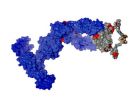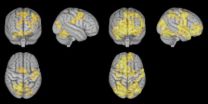(Press-News.org) This news release is available in German.
Custom-tailored antibodies are regarded as promising weapons against a multitude of serious illnesses. Since they can accurately recognize specific structures on the surface of viruses, bacteria or cancer cells, they are already being deployed successfully in cancer diagnostics and therapy, as well as against numerous other diseases. The stability of the sensitive antibodies is a decisive factor in every step, from production and storage to therapeutic application.
A team of researchers headed by Dr. Matthias J. Feige and the professors Linda Hendershot of St. Jude Children's Research Hospital in Memphis (Tennessee, USA), Michael Sattler (Chair of Bimolecular NMR Spectroscopy at TU Muenchen and the Institute for Structural Biology at the Helmholtz Zentrum Muenchen), Michael Groll (Chair of Biochemistry at TU Muenchen) and Johannes Buchner (Chair of Biotechnology at TU Muenchen) set out to find new approaches for stabilizing antibodies by comparing mammalian antibodies with those of sharks.
Sharks have been in existence for over 500 million years. From an evolutionary perspective they are among the oldest animals with a "modern" immune system not unlike that of humans. Shark blood contains large quantities of urea, allowing the animal to survive in salt water. While urea protects sharks from dehydration, it can also destabilize sensitive protein molecules such as antibodies.
"Human antibodies would collapse under these conditions. Shark antibodies must, therefore, possess structural characteristics that make them particularly robust," says Matthias J. Feige, lead author of the publication. "We wanted to unravel this mystery."
Meticulous puzzle work
The researchers chose the IgNAR (immunoglobulin new antigen receptor) shark antibody for their investigations. Lacking structural information on the molecule and due to the fact that the molecule could not be completely crystallized, they developed a model of the antibody in detective-like puzzle work.
They crystallized parts of the antibody and determined their atomic structures using X-ray crystallography, comparing the segments with previously known structures of other immunoglobulins. For other antibody segments, they analyzed the structures using NMR spectroscopy. Time and again the researchers compared the determined structures and spatial distances with the results of X-ray diffraction measurements of natural shark antibody molecules to then finally construct a comprehensive model of the IgNAR antibody.
Precise examination of the protein's structure revealed that the Ig folding typical for antibodies had already developed over 500 million years ago, since it is also present in sharks. Moreover, the researchers were able to identify the source of the of shark antibody stability: It results from an additional salt bridge between structurally important amino acid chains and a particularly large non-polar nucleus of the Ig fold in shark antibodies.
Human antibodies with enhanced stability
The researchers succeeded in integrating both stabilizing principles into human antibodies. In fact, the combination of both principles led to a significant increase of stability of the human antibody fragments. Their melting point was 10 degrees higher than that of the original molecule.
The increased stability also showed a positive effect in mammalian cells that typically produce therapeutic antibodies: The altered antibodies were produced in significantly larger quantities. In the near future, so the expectation of the researchers, this insight will enable the development of improved therapeutic and diagnostic antibodies. They should become easier to fabricate and store, as well as remain active longer inside the human organism, allowing them to unfurl their full therapeutic potential.
INFORMATION:
This work was supported by grants from the National Institutes of Health, the German Research Foundation (DFG), the Excellence Cluster Center for Integrated Protein Science Munich (CIPSM), the Leopoldina National Academy of Sciences, the Paul Barrett endowed fellowship of St. Jude Children's Research Hospital, the Peter und Traudl Engelhorn Stiftung, the German National Academic Foundation, the European Molecular Biology Organization (EMBO), the Swedish Research Council (Vetenskapsrådet), and the Boehringer Ingelheim Fund. NMR measurements were done at the Bavarian NMR Center (BNMRZ). X-ray-data were collected at the Swiss Light Source (Villigen, Switzerland).
Publication:
The structural analysis of shark IgNAR antibodies reveals evolutionary principles of immunoglobulins
Matthias J. Feige, Melissa A. Graewert, Moritz Marcinowski, Janosch Hennig, Julia Behnke, David Ausländerb, Eva M. Herold, Jirka Peschek, Caitlin D. Castro, Martin Flajnik, Linda M. Hendershot, Michael Sattler, Michael Groll, and Johannes Buchner
PNAS, Early Edition, week of May 12-16, 2014
Learning from sharks
Shark antibodies inspire optimization of human antibodies
2014-05-15
ELSE PRESS RELEASES FROM THIS DATE:
Where have all the mitochondria gone?
2014-05-15
It's common knowledge that all organisms inherit their mitochondria – the cell's "power plants" – from their mothers. But what happens to all the father's mitochondria? Surprisingly, how – and why – paternal mitochondria are prevented from getting passed on to their offspring after fertilization is still shrouded in mystery; the only thing that's certain is that there must be a compelling reason, seeing as this phenomenon has been conserved throughout evolution.
Now, Dr. Eli Arama and a team in the Weizmann Institute's Molecular Genetics Department have discovered special ...
Sugar implicated in cardiovascular disease risk independent of weight gain
2014-05-15
Researchers from New Zealand's University of Otago have uncovered evidence that sugar has a direct effect on risk factors for heart disease, and is likely to impact on blood pressure, independent of weight gain.
Research Fellow with Otago's Department of Human Nutrition Dr Lisa Te Morenga, Professor Jim Mann and colleagues have conducted a review and meta-analysis of all international studies that compared the effects of higher versus lower added sugar consumption on blood pressure and lipids (blood fats or cholesterol) – both of which are important cardiovascular risk-factors.
They ...
This is your brain on meditation
2014-05-15
Mindfulness. Zen. Acem. Meditation drumming. Chakra. Buddhist and transcendental meditation. There are countless ways of meditating, but the purpose behind them all remains basically the same: more peace, less stress, better concentration, greater self-awareness and better processing of thoughts and feelings.
But which of these techniques should a poor stressed-out wretch choose? What does the research say? Very little – at least until now.
A team of researchers at the Norwegian University of Science and Technology (NTNU), the University of Oslo and the University ...
HIV patient nutrition more vital than once assumed
2014-05-15
Roughly 25 million Africans live with HIV, many of who now have access to antiretroviral drugs (ARVs). Among their side effects, ARVs can cause patients to put on weight. Subsequently, attention paid to malnutrition among African HIV patients has waned. However, widespread malnutrition has been identified as a reason that up to a quarter of HIV patients in a number of African countries die just months after beginning medical treatment.
A collaborative project between the University of Copenhagen and Jimma University, Ethiopia has demonstrated that daily nutritional supplementation ...
The state of rain
2014-05-15
Using modern weather satellites to monitor rainfall has become a robust, widely practiced technique. However, establishing a reliable context for relating space-based rainfall observations to current and historical ground-based rainfall data has been difficult.
A new dataset developed in partnership between UC Santa Barbara and the U.S. Geological Survey (USGS) can be used for environmental monitoring and drought early warning. The Climate Hazards Group Infrared Precipitation with Stations (CHIRPS), a collaboration between UCSB's Climate Hazards Group and USGS's Earth ...
Study finds hazardous flame retardants in preschools
2014-05-15
Berkeley — A new study of preschools and day care centers finds that flame retardants are prevalent indoors, potentially exposing young children to chemicals known to be hazardous.
The study, to appear online Thursday, May 15, in the journal Chemosphere, was led by researchers at the University of California, Berkeley, and funded by the California Air Resources Board. Although many infants and young children spend up to 50 hours per week in day care, the study authors noted that this paper represents the first systematic review of flame retardants in early child care ...
West Antarctic Ice Sheet collapse is under way
2014-05-15
The West Antarctic Ice Sheet, which holds enough water to raise global seas by several feet, is thinning. Scientists have been warning of its collapse, based on theories, but with few firm predictions or timelines.
University of Washington researchers used detailed topography maps and computer modeling to show that the collapse appears to have already begun. The fast-moving Thwaites Glacier will likely disappear in a matter of centuries, researchers say, raising sea level by nearly 2 feet. That glacier also acts as a linchpin on the rest of the ice sheet, which contains ...
Phase I data suggest PLX3397 is a potential therapy for patients with advanced PVNS
2014-05-15
NEW YORK, NY, May 14, 2014 — A novel targeted drug shows promise in treating patients with advanced pigmented villonodular synovitis (PVNS), a rare neoplastic joint disorder, according to new phase I data from Memorial Sloan Kettering Cancer Center and other institutions highlighted to media today in advance of the 50th Annual Meeting of the American Society of Clinical Oncology (ASCO), which will take place from May 30 to June 3 in Chicago.
At the time of interim analysis, 11 of 14 evaluable patients (79 percent) had a partial response to the drug and three patients ...
Critical access hospitals have higher transfer rates after surgery
2014-05-14
Hospital transfers happened more often after surgery at critical access hospitals (CAHs) but the proportion of patients using post-acute care was equal to or less than that of patients treated at non-CAHs.
The CAH designation was created to provide financial support to rural hospitals. As such, they are exempt from Medicare's Prospective Payment System and instead are paid cost-based reimbursement. The proliferation of CAHs after the payment policy change has increased interest in the quality and cost of care these facilities provide.
The authors used data from ...
Study examines prenatal exposure to tobacco smoke on inhibition control
2014-05-14
Individuals prenatally exposed to tobacco smoke exhibited weaker response in some regions of the brain while processing a task that measures inhibition control (the ability to control inappropriate responses).
Prenatal tobacco smoke exposure is a risk factor for adverse physical and mental outcomes in children. Growing evidence suggests that smoking during pregnancy may increase the risk of psychopathology such as attention-deficit/hyperactivity disorder (ADHD). Research on ADHD has suggested that individuals with the disorder may exhibit poor inhibitory control.
Functional ...
LAST 30 PRESS RELEASES:
Numbers in our sights affect how we perceive space
SIMJ announces global collaborative book project in commemoration of its 75th anniversary
Air pollution exposure and birth weight
Obstructive sleep apnea risk and mental health conditions among older adults
How talking slows eye movements behind the wheel
The Ceramic Society of Japan’s Oxoate Ceramics Research Association launches new international book project
Heart-brain connection: international study reveals the role of the vagus nerve in keeping the heart young
Researchers identify Rb1 as a predictive biomarker for a new therapeutic strategy in some breast cancers
Survey reveals ethical gaps slowing AI adoption in pediatric surgery
Stimulant ADHD medications work differently than thought
AI overestimates how smart people are, according to HSE economists
HSE researchers create genome-wide map of quadruplexes
Scientists boost cell "powerhouses" to burn more calories
Automatic label checking: The missing step in making reliable medical AI
Low daily alcohol intake linked to 50% heightened mouth cancer risk in India
American Meteorological Society announces Rick Spinrad as 2026 President-Elect
Biomass-based carbon capture spotlighted in newly released global climate webinar recording
Illuminating invisible nano pollutants: advanced bioimaging tracks the full journey of emerging nanoscale contaminants in living systems
How does age affect recovery from spinal cord injury?
Novel AI tool offers prognosis for patients with head and neck cancer
Fathers’ microplastic exposure tied to their children’s metabolic problems
Research validates laboratory model for studying high-grade serous ovarian cancer
SIR 2026 delivers transformative breakthroughs in minimally invasive medicine to improve patient care
Stem Cell Reports most downloaded papers of 2025 highlight the breadth and impact of stem cell research
Oxford-led study estimates NHS spends around 3% of its primary and secondary care budget on the health impacts of heat and cold in England
A researcher’s long quest leads to a smart composite breakthrough
Urban wild bees act as “microbial sensors” of city health.
New study finds where you live affects recovery after a hip fracture
Forecasting the impact of fully automated vehicle adoption on US road traffic injuries
Alcohol-related hospitalizations from 2016 to 2022
[Press-News.org] Learning from sharksShark antibodies inspire optimization of human antibodies



